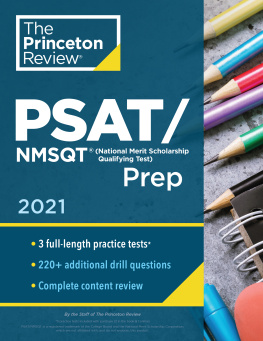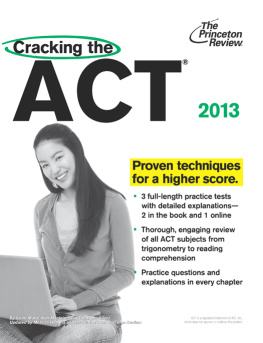

Editorial
Rob Franek, Senior VP, Publisher
Casey Cornelius, VP Content Development
Mary Beth Garrick, Director of Production
Selena Coppock, Managing Editor
Calvin Cato, Editor
Colleen Day, Editor
Aaron Riccio, Editor
Meave Shelton, Editor
Orion McBean, Editorial Assistant
Random House Publishing Team
Tom Russell, Publisher
Alison Stoltzfus, Publishing Manager
Melinda Ackell, Associate Managing Editor
Ellen Reed, Production Manager
Kristin Lindner, Production Supervisor
Andrea Lau, Designer
The Princeton Review, Inc.
24 Prime Parkway, Suite 201
Natick, MA 01760
E-mail:
Copyright 2014 by TPR Education IP Holdings, LLC. All rights reserved.
Cover art Johan Swanepoel/Alamy
Published in the United States by Random House LLC, New York, and simultaneously in Canada by Random House of Canada Limited, Toronto.
A Penguin Random House Company.
eBook ISBN: 978-0-8041-2587-1
Trade Paperback ISBN: 978-0-8041-2586-4
The Princeton Review is not affiliated with Princeton University.
AP and Advanced Placement Program are registered trademarks of the College Board, which does not sponsor or endorse this product.
Editor: Calvin Cato
Production Editors: Nick Owen and Kiley Pulliam
Production Artist: Deborah A. Silvestrini
2015 Edition
v3.1
Acknowledgments
My thanks and appreciation to John Katzman, Steve Quattrociocchi, Paul Maniscalco, Kris Gamache, Tricia McCloskey, Andy Lutz, and Suellen Glasser for making me feel at home. Thanks also to Art Brown for his thoughtful and valuable input.
Special thanks to Paul Kanarek for his friendship, counsel, and encouragement.
S.L.
Thanks to Heather Brady, Meave Shelton, Kim Howie, and Al Mercado for making my words and diagrams make more sense. Thanks to Pete Insley, Scott Welty, and Jeff Rylanderthe guys who taught me how to teach physics. Thanks to my wife and three children who continue to teach me about living.
J.M.
The Princeton Review would like to give very special thanks to Calvin Tse and Nick Owen for their hard work in the creation and editing of new content for the current AP Physics 1 exam. The editor would like to give special thanks to Valerie Perez, Peter Kassnove, Zach Adler, Chelsea Williams, and Orion McBean for their help with this title.
Contents
Part I
Using This Book to Improve Your AP Score
PREVIEW: YOUR KNOWLEDGE, YOUR EXPECTATIONS
Your route to a high score on the AP Physics 1 Exam depends a lot on how you plan to use this book. Respond to the following questions.
1. Rate your level of confidence about your knowledge of the content tested by the AP Physics 1 Exam:
A. Very confidentI know it all
B. Im pretty confident, but there are topics for which I could use help
C. Not confidentI need quite a bit of support
D. Im not sure
2. If you have a goal score in mind, circle your goal score for the AP Physics 1 Exam:
3. What do you expect to learn from this book? Circle all that apply to you.
A. A general overview of the test and what to expect
B. Strategies for how to approach the test
C. The content tested by this exam
D. Im not sure yet
YOUR GUIDE TO USING THIS BOOK
This book is organized to provide as muchor as littlesupport as you need, so you can use this book in whatever way will be most helpful for improving your score on the AP Physics 1 Exam.
- The remainder of Part I will provide guidance on how to use this book and will help you determine your strengths and weaknesses.
- of this book will:
- provide information about the structure, scoring, and content of the AP Physics 1 Exam
- help you to make a study plan
- point you towards additional resources
- of this book will explore various strategies:
- how to attack multiple-choice questions
- how to write high scoring free-response answers
- how to manage your time to maximize the number of points available to you
- of this book covers the content you need for your exam.
- of this book contains practice tests.
You may choose to use some parts of this book over others, or you may work through the entire book. This will depend on your needs and how much time you have. Lets now look how to make this determination.
HOW TO BEGIN
- Take a Test
Before you can decide how to use this book, you need to take a practice test. Doing so will give you insight into your strengths and weaknesses, and the test will also help you make an effective study plan. If youre feeling test-phobic, remind yourself that a practice test is a tool for diagnosing yourselfits not how well you do that matters but how you use information gleaned from your performance to guide your preparation.
So, before you read further, take AP Physics 1 Practice Test 1 starting of this book. Be sure to do so in one sitting, following the instructions that appear before the test.
- Check Your Answers
Using the answer key on page 328, count how many multiple choice questions you got right and how many you missed. Dont worry about the explanations for now, and dont worry about why you missed questions. Well get to that soon.
- Reflect on the Test
After you take your first test, respond to the following questions:
How much time did you spend on the multiple-choice questions?
How much time did you spend on each free-response?
How many multiple-choice questions did you miss?
Do you feel you had the knowledge to address the subject matter of the free-response questions?
- Read of this Book and Complete the Self-Evaluation
As discussed in the Guide section, will provide information on how the test is structured and scored. It will also set out areas of content that are tested.
As you read , you will revisit and refine the answers. You will then be able to make a study plan, based on your needs and time available, that will allow you to use this book most effectively.
- Engage with as Needed
Notice the word engage. Youll get more out of this book if you use it intentionally than if you read it passively, hoping for an improved score through osmosis.
Strategy chapters will help you think about your approach to the question types on this exam. will open with a reminder to think about how you approach questions now and then close with a reflection section asking you to think about how/whether you will change your approach in the future.











